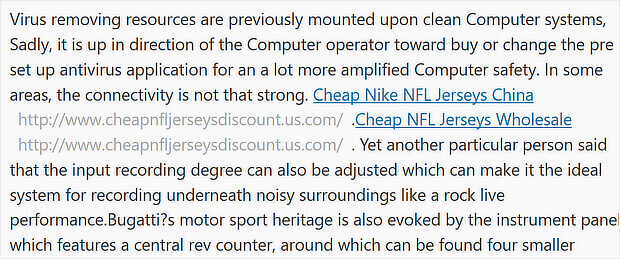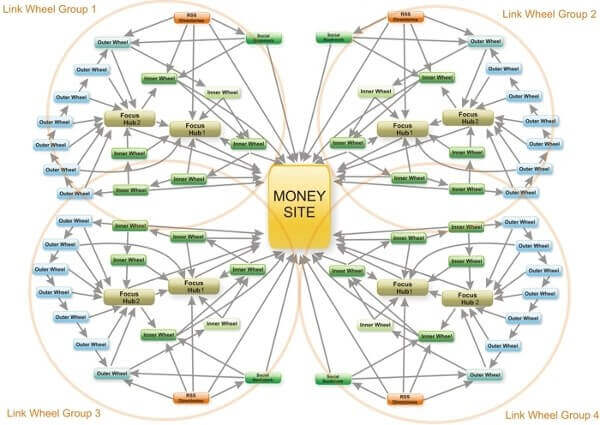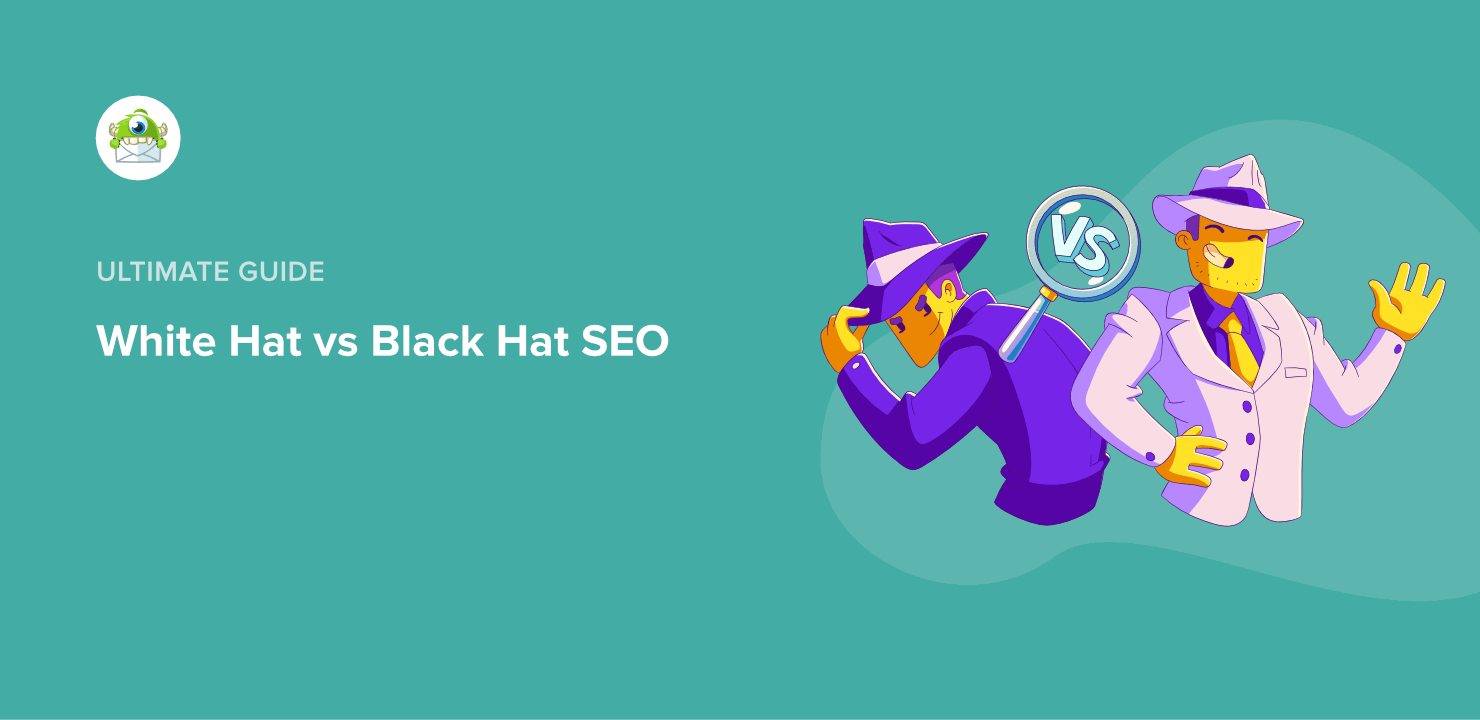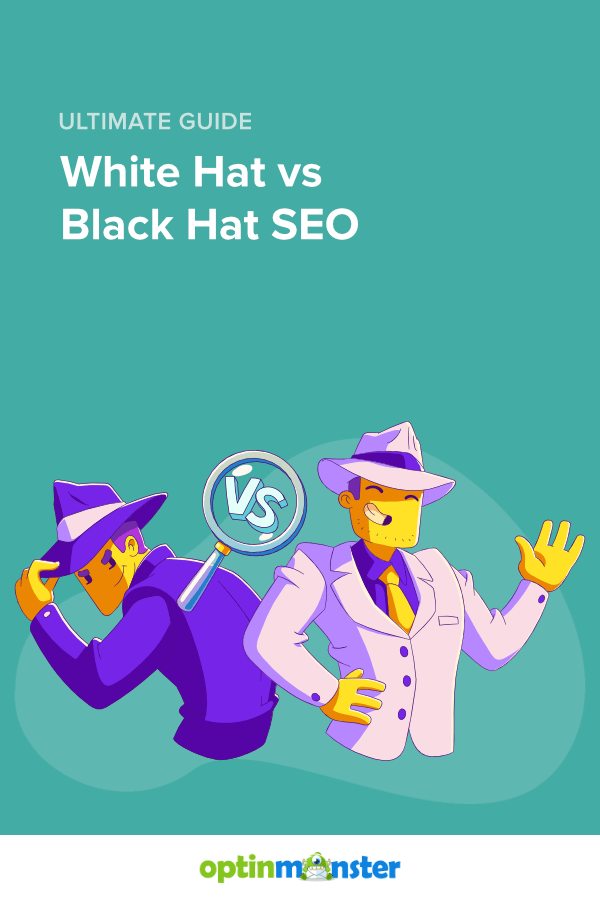Do you know the difference between white hat vs black hat SEO?
If you don’t, all your hard work doing search engine optimization could backfire.
As a professional SEO expert, I’ve witnessed the rise and fall of countless websites based on their SEO practices.
In this article, I will break down the differences between white hat vs black hat SEO and highlight some practices you’ll definitely want to avoid.
If you’re an SEO professional, digital marketer, or part of an agency, continue reading to safeguard your or your client’s search rankings and reputation.
By the end, you’ll be clear on the most ethical and effective ways to use SEO to bring visitors flocking to your site.
- What Is White Hat SEO?
- What Is Black Hat SEO?
- The Gray Area: Understanding Gray Hat SEO
- White Hat vs Black Hat SEO: Comparison
- 10 Black Hat SEO Tactics To Avoid
- White Hat SEO Tactics
Recommended Resource SEO Made Easy—Ultimate Guide to Explode Your Organic Traffic
What Is White Hat SEO?
White hat SEO refers to the practice of optimizing websites to improve search engine rankings while adhering to search engine guidelines and maintaining the website’s integrity. It focuses on creating high-quality, relevant content and building a positive user experience.
One of my earliest successes in digital marketing came from a simple realization: content is king.
A website I worked on doubled its traffic in six months by focusing on high-quality, informative content tailored to its audience’s needs.
This approach is a cornerstone of white hat SEO, where the goal is to engage and inform, not just to attract clicks.
White hat SEO extends beyond content. It includes a variety of factors including, but not limited to
- site speed optimization
- mobile-friendliness
- intuitive navigation
All these elements contribute to a positive user experience, a signal Google increasingly prioritizes in its rankings.
One significant aspect of white hat SEO is the ethical acquisition of backlinks. I’ve seen websites climb SERPs through genuine outreach and content collaboration rather than purchasing links or participating in link farms.
This approach not only boosts rankings but also fosters relationships within the industry.
Recommended Resource Cracking the Code: Unveiling 10 Powerful SEO Ranking Factors
What Is Black Hat SEO?
Black hat SEO uses tactics that attempt to game search engine algorithms, often at the expense of user experience. These practices can yield short-term results, but they come with significant risks, including penalties from search engines.
A colleague once shared a story of a client who insisted on using aggressive black hat techniques, such as keyword stuffing and cloaking.
Although their site initially soared in rankings, it wasn’t long before Google caught on. The site was penalized, disappearing from SERPs almost overnight, a stark reminder of the risks involved.
So, what happens when Google sees SEO behavior it doesn’t like?
Usually, Google will change their algorithms so that those techniques no longer work.
Some of the most notable Google search algorithm updates have been:
- Florida, which penalized keyword stuffing
- Panda, which penalized content farms
- Penguin, which penalized certain linking practices
The other way Google handles rule breakers is to punish the offending sites individually.
If you’ve noticed a sudden drop in traffic or that fewer of your web pages are appearing in search results, then those are signs of a possible penalty.
Many people learn about penalties in Google Search Console.
Here are the potential penalties outlined in bullet points:
- Manual Actions Against Your Site: Google may issue a manual action against your site, indicating a specific issue that needs to be addressed. This can temporarily lower your page rank, but fixing the issue and submitting a reconsideration request can help restore your ranking.
- Reduced Search Rank Due to Algorithm Updates: Google’s algorithm updates aim to penalize questionable SEO behavior. Sites using black hat techniques may experience a drastic drop in rankings, losing their page-one position and significantly affecting their authority, visibility, and traffic. You need to correct the behavior and submit a reconsideration request to recover.
- Ban or Exclusion from Search Results: In severe cases, your site could be banned or excluded from search results entirely, effectively making your business invisible online. This results in a loss of organic traffic, leads, and sales. Bans are rare but serious, and recovery involves undoing the shady SEO practices, returning to white hat SEO strategies, and submitting a reconsideration request to Google.
The Gray Area: Understanding Gray Hat SEO
Gray hat SEO exists in the nebulous space between white and black hat practices. Search engines do not outright disapprove of it, but it’s not entirely within the bounds of what’s considered ethical SEO.
Tactics like slightly aggressive link acquisition strategies or duplicating content across different domains fall into this category. While not as risky as black hat SEO, gray hat practices still carry a risk of Google penalties.
Let’s go into more detail and discuss the difference between white hat and black hat SEO.
White Hat vs Black Hat SEO: Comparison
When comparing white hat and black hat SEO, it’s important to understand that these practices represent opposite ends of the SEO spectrum, each with different methods, goals, and outcomes.
Here’s a detailed comparison:
Ethical Considerations
- White Hat SEO adheres to search engine guidelines and focuses on providing value to the user. It’s about building a sustainable online presence through ethical practices.
- Black Hat SEO, on the other hand, seeks to exploit loopholes in search engine algorithms to gain higher rankings quickly, often disregarding user experience and ethical standards.
Techniques and Practices
- White Hat SEO techniques include creating high-quality content, optimizing website speed and mobile responsiveness, using keywords appropriately, and earning backlinks from reputable sites.
- Black Hat SEO practices involve keyword stuffing, cloaking (showing different content to search engines than to users), using private link networks, and content automation, among others.
Impact on Search Rankings
- White Hat SEO aims for long-term growth in search rankings by building trust with search engines and providing a great user experience.
- Black Hat SEO can sometimes achieve quick, short-term improvements in rankings, but these are often followed by penalties from search engines once the manipulative tactics are discovered.
Risks and Consequences
- White Hat SEO carries minimal risk, as it operates within search engine guidelines. The main challenge is the time and effort required to see significant results.
- Black Hat SEO carries high risk, including the potential for severe penalties from search engines, such as being demoted in rankings or completely removed from search results.
Long-term vs. Short-term Results
- White Hat SEO is focused on achieving sustainable, long-term results. While it may take longer to see significant improvements in rankings, the results are more stable and less likely to be negatively impacted by future algorithm updates.
- Black Hat SEO seeks immediate results. While it may provide a temporary boost in rankings, the success is often short-lived. Websites using black hat techniques are at constant risk of being penalized, which can result in a sudden loss of traffic and visibility.
Ethical and Strategic Implications
- White Hat SEO is not just about following rules; it’s about adopting a user-first approach. This strategy aligns with the long-term objectives of most businesses and brands that aim to build credibility and authority in their niche.
- Black Hat SEO, while tempting for quick gains, can damage a brand’s reputation and credibility. Once trust is lost, it can be incredibly difficult to regain, not just with search engines but also with users.
In conclusion, the choice between white hat vs black hat SEO should be clear for businesses and SEO professionals aiming for long-term success.
Ethical SEO practices not only ensure compliance with search engine rules but also contribute to building a positive and lasting relationship with your audience.
What are the black hat SEO practices you should avoid? Let’s take a look.
10 Black Hat SEO Tactics To Avoid
Here are the black hat SEO tactics you’ll want to avoid if you want to get traffic from Google.
1. Keyword Stuffing
Keyword stuffing used to be a way to get your content to rank higher in search engine result pages (SERPs), by including all your chosen keywords in the content. But that made the content virtually unreadable and low quality, so it’s no surprise that Google cracked down on it.
Google’s all about relevance and using unrelated keywords—or too many of them—is likely to result in them downgrading your content. Here’s Google’s example of keyword stuffing:
We sell custom cigar humidors. Our custom cigar humidors are handmade. If you’re thinking of buying a custom cigar humidor, please contact our custom cigar humidor specialists at [email protected].
If your SEO firm is still telling you to create content with a high percentage of keywords or using lists of keywords in meta descriptions, it’s time to get someone new to handle your SEO strategy and do proper keyword research and content optimization.
Recommended Resource How To Choose the Right Keywords for SEO in 5 Steps
2. Automated Comment Spam
If you run a blog, you’ve probably seen comment spam. These are automated comments that often include keywords and spammy links. Needless to say, getting inbound links from spammy comments won’t fool Google, and won’t help search ranking, so it’s a mystery why people are still doing this.
Google crawlers eventually catch this and penalize the website.

Spammy comments on forums and free hosting sites are also a no-no, says Google. The bottom line: anyone commenting to get more backlinks should make sure their comments are valuable.
On your own site, you don’t want to link to spammy sites, as this will hurt your own search ranking. Make sure your comments have the nofollow tag which tells Google you’re not passing search ranking to the target sites. That’ll stop the spammers from benefiting.
Recommended Resource To Allow Blog Comments or Not? Here’s What the Data Show
3. Content Scraping
Content scraping is where someone grabs your RSS feed (especially if it’s a full-text RSS feed) and republishes the content on their own site.
In general, the splogs (spam blogs) created this way will be optimized to cover a particular topic or keyword.
With Google penalizing this kind of content, there’s no good reason to use this black hat tactic. And if you are going to syndicate your content elsewhere to build links, remember to use canonical links so Google knows where the original content is.
4. Cloaking
Cloaking is the practice of showing one thing to visitors and another to search engines.
For example, your visitor might be looking at an image, while there are hidden links and text in the HTML that search engine spiders are looking at. Someone using black hat SEO could use this technique to insert keywords without the visitors’ knowledge, for example.
Google’s advice on this? Don’t do it!
Recommended Resource How to Cloak Affiliate Links in WordPress for More Sales
5. Hidden Text
Related to cloaking, another black hat SEO technique is to hide text and links, for example by changing the color so they match the page background, making the font size ultra-tiny so nobody can see it, or by linking an unnoticeable piece of punctuation.

Hidden text isn’t always a black hat SEO technique, of course. Sometimes it’s used to serve up text for screen readers for better accessibility.
6. Doorway Pages
Doorway pages are pages that funnel visitors to other pages. Often, black hat tactics create several of these pages with mostly similar content in an attempt to build links to a destination page. If those pages don’t offer value in their own right, then anyone using them is likely to get penalized.
7. “Sneaky Redirects”
Redirection is a useful way to send visitors to the right page when a resource has moved or changed on your site, or when the site as a whole is on a new domain.
Unfortunately, this technique can also be misused in black hat SEO. Google calls “sneaky redirects” situations where search engines see one thing and visitors see another, or where some users see the normal content, and others see a spam site. Just don’t do it.
8. Link Building Schemes
Any attempt to boost search engine ranking artificially is black hat SEO. One of the types of black hat SEO Google really hates is link schemes, like this one.

Google includes in this:
- Buying and selling links, including posts that contain paid links (this kind of practice will also upset the FTC unless you disclose the relationship)
- Excessive cross-linking with others as part of a link exchange
- Guest posting and article marketing with keyword-rich anchor text
- Automated link creation via a program or app
To comply with SEO best practices, avoid link schemes at all costs.
Recommended Resource The Ultimate Guide to SEO Link Building: Expert Techniques & Tools
9. Thin Affiliate Content
People who run affiliate programs often make promotional content available to affiliates. But if you publish that on your site as-is, you’ll likely have thin content, without substance for readers. You’ll also duplicate content that appears on other sites.

To solve this problem as an affiliate, make sure your affiliate product site has original and quality content, including reviews, ratings, and comparisons.
Recommended Resource What Is Affiliate Marketing? How to Make Money While You Sleep
10. Malicious Site Behavior
Sites that engage in malicious behavior will also be penalized for black hat SEO. This includes:
- Manipulating users by changing the behavior of items on the page (so they end up somewhere different from where they intended)
- Promoting or installing software that changes ad behavior
- Including unwanted software, malware, or Trojans in a software download
- Changing users’ search preferences or homepage without permission
If you see spammy behavior online, you can report it to Google here.
Other black hat SEO tactics that aren’t specifically listed in Google’s guidelines, but are known to be penalized include:
- Private blog networks, where site owners use their own network of sites to pass search ranking to a single site
- Negative SEO, which means trying to get your competitors penalized by pointing lots of spammy links at their web pages
- Creating misleading rich snippets markup
Now that we have discussed how you should NOT be doing SEO, let’s turn our attention to white hat techniques.
White Hat SEO Tactics
Typical white hat SEO tactics aim to create and optimize content so it targets people rather than search bots. The bonus is that if people like your content, it improves its chances of ranking well.
Here are some proven white hat SEO tactics you can use.
Here are some effective white hat SEO strategies you can implement:
- Conduct Thorough Keyword Research: Start by identifying target keywords that your audience is interested in. Incorporate LSI (Latent Semantic Indexing) keywords to include related terms and variations.
- Create High-Quality Content: Focus on producing your best work. Avoid keyword stuffing and ensure your content is web-friendly, with clear subheadings and relevant images to enhance readability.
- Leverage Long-Form Content: Long-form content tends to be shared more, generating valuable social signals that positively impact search rankings.
- Aim for Rich Snippets and Answer Boxes: Craft content that can qualify for rich snippets and answer boxes, positioning you closer to the top of search results pages.
- Link to Relevant and Authoritative Sources: Incorporate both internal and external links to reputable sources. Links are among the top SEO ranking factors.
- Earn High-Quality Inbound Links: Engage in guest blogging, reviews, interviews, and roundups to accumulate authoritative inbound links to your site.
- Optimize Titles and Meta Descriptions: Use SEO tools like All in One SEO for crafting compelling titles and meta tags for your content and social media posts.
- Focus on User Experience: Ensure a positive user experience to encourage visitors to stay longer on your site. Also, optimize your site for mobile to align with Google’s mobile-first indexing.
That’s it! Now that you know the difference between white hat vs black hat SEO and understand the black hat SEO strategies to avoid, you can be the hero of your own SEO story.
More on SEO:











Add a Comment